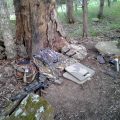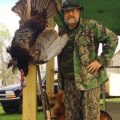So you want to hunt turkeys, huh?
I have never claimed to be an expert Turkey Hunter. I only claim to be an expert Beginning Turkey Hunter. I started hunting turkeys back during Reagan’s first term. I still consider myself a beginner. If I were just starting out turkey hunting this year, here’s what I’d be doing.
First off, I would be concentrating on where I was hunting. If more than 35 seasons at this, I can tell you that turkeys are very much tied to the land. What a gobbler does this morning is intractably linked to what his great-great-granddaddy did. Some things change. Roost trees blow down. Somebody clearcuts the neighboring plot. However, turkeys do what turkeys do, and it is hard to change it. If turkeys came into a pasture from a hole in the fence half a century ago, if that hole is still there, they’ll be coming through now. For you that means studying up on topos, getting on Google Earth, and then going out and listening for the birds. Even in the dead of winter, you can hear birds on the roost. Even if the gobblers are not gobbling yet, you can pinpoint roost trees.
Next, learn the birds. There is nothing and I mean nothing like the lessons the turkeys will teach you themselves. Get out there and listen to the birds. February in the Trans-Bluegrass is cold and miserable, but you’ll be glad you went out if you can hear birds on the roost. The hens give a master class nearly every morning. Once you find patterns in their movement, try to get ahead of the birds and be sitting there waiting for them to show up. Listen to how hens talk to each other when they are moving and feeding. You’ve got my podcasts and CD’s like the Spittin’ Feathers series to guide you, but there is nothing like the real thing. Learn their cadences. Learn their voicings. Learn as much as you can about turkeys in the wild. I get back to turkey camp usually around the first of March. Every morning I can, I’m out scouting the birds. What I learn is invaluable. That is why I record the podcasts– to share them with you. I’d be the first to tell you it does not match the complexity and depth a day in the field buys you.
Gear is a lot easier than you think. My absolute best run-ins with gobblers have nearly all occurred when I was not dressed in my turkey hunting duds. Dressed in a barn coat and brown carhart bibs, I once had ten gobblers clustered around me strutting in nearly arms reach while I drank my coffee out of a stainless steel cup. Camo is a good idea, but do not go overboard. Nearly any camo will do. They say browns on the bottom and greens on top, but that is not a hard and fast rule. I prefer old military patterns like Woodland, Flectarn, and British DPM. Let me describe my kit, and you can go from there:
Fleecy Poly-Pro underwear from SportsmansGuide.com.
Uninsulated Camo Bibs.
Black or Green Wool Commando Sweater
Woodland Camo M65 jacket or Camo shirt
Camo Boonie hat with a camo veil
Camo Gloves
In colder weather, I add a wool balaclava and wool mittens. In warmer weather I loose the underwear and sweater and jacket and just wear a camo long-sleeve T-shirt.
Footwear was an issue with me for years. I finally settled on a $35 dollar pair of duck boots. However, I’ve tried everything from Vietnam issue jungle boots to rubber bowhunters boots to insulated goretex hunting boots. The trick for me was finding something that would keep my feet warm and dry in the mornings and not be too hot walking out in the afternoon.
I don’t like turkey vests. I think they’re noisy and cumbersome. I carry a messenger bag, and I hang a foam buttpad off of the strap. You need something to sit on. Look around on this weblog. I’ve written about it alot. I also carry a musette bag on the other side for the bulky things like my rain gear, my lunch, and so on. The musette bag is also where I carry all my extra clothing that I take off after the weather warms up.
Calls:
I carry a box call, a couple of pot calls, a push-pin call and a few mouth calls. I do not carry the kitchen sink. I use the box call for long distances, the pot calls to the lion share of the work. I use the mouth calls for a change-up, and for those hung-up gobblers to come in the last few yards. The push-pin call is another change-up. I find it works best for me for clucking and purring. For some reason I can’t purr with a mouth call. Most beginners make the mistake of concentrating on their calling to the detriment of everything else. Don’t call too much. Don’t call too loudly. You will be ahead of most beginners if you learn that lesson.
Guns and Ammo:
Here is the other aspect of turkey hunting that seems like a bottomless hole. My rig is a 12 GA Mossberg 500 pump with a 28 inch ported barrel, I’m shooting a #4 lead 3-inch Federal shells through a Carlson’s Dead Coyote choke. My son fires #4 2 3/4″lead Remington Nitro Buffered Magnums out of his Remington 870. These are loads that we’ve been shooting since 1996. Don’t feel you have to spend $8/round to hunt turkeys. Don’t feel you need to reach out 60 yards with your gun. The vast majority of my birds have been taken inside 20 yards. This is one time where a cheap pump gun shines. Grand Dad’s trap gun will do just fine. I prefer having a dedicated turkey gun, if for no other reason that this is a gun that will get nicked and scratched more than other shotguns. I spraypainted mine. If you’re going to buy a turkey gun, look for a cheap, used pump with screw-in choke tubes and then buying a tight turkey choke. I’ve helped friends get into the sport and found them an old riot gun, and then ordered a used barrel off Ebay or Gunbroker that was tapped for choke tubes. My one son started off with an old bolt-action 20 GA. As long as you can put a few pellets in a Dixie Cup at 25 yards you’re good to start.
Read the Regs
Get hold of your state’s hunting rules for turkey and read them cover to cover. Don’t break the law. Don’t skirt the law. I’ve screwed up a few times over the years, and I am glad a warden was not there watching. In one case, I brought #2 shot out on a hunt in a state that required no bigger shot than #4. In another, I missed a change in the date of the Opener. I also nearly broke the rules in Kentucky regarding the use of an electronic decoy. These are the stupid mistakes that could have cost me a fine and loss of hunting privileges.
If you still need Hunter Education, get it. I was grandfathered in, and did not take the course until I was 45 and going through with my eldest son. I liked it so much I went through again with my youngest when his time came. I learned something new each time.
Okay, back to the turkeys.
The ace #1 thing to successful turkey hunting is having turkeys to hunt. That sounds stupid, but I went my first 10 years without shooting a bird. It took me 3 years just to see a gobbler. This was at a time when I had to drive 5 counties over just to get into a place where it was legal to hunt them. My point is that once I got onto property with a decent population of birds, I started being successful. In my early years, I was trying to call birds from another property. I was hunting barren public land where I never saw a bit of sign or heard a bird. Make sure you have turkeys to hunt before you try to hunt them.
The second thing to do is to try to latch onto a successful turkey hunter and go with him. There are a lot of guys who are willing to call birds for a guy who still has open tags. If you find a fellow, wine him. Dine him. Let him date your sister. You will learn more in a morning or two with him than you may learn in several seasons alone.
Third: forget what you see on TV. Turkey hunting shows are a farce. They make it look like everything gets done in 30 minutes with time out for commercials. It’s true. I’ve had my Opening Day Tag filled in less than an hour. However, it is more likely you’ll have racked up dozens of hours of hunting before you are successful. Get used to the idea that this is the hardest game on the North American Continent. Turkeys aren’t that hard to kill. We just made it deliberately hard so they wouldn’t go extinct. Early settlers shot them out of their roosts, shot them with rifles, and baited them with corn. Given modern rules it is near impossible to bag a bird.
Four: Everyone gets the idea that calling gobblers off the roost is THE game. It isn’t. When you are starting out, forget about getting close to a roost tree and calling that gobbler so he will pitch down and come to you. Instead, concentrate on finding where the turkeys go after flydown, after the gobbler has had his way with his harem of hens. Go to where the turkeys go to feed mid-morning and wait for them there. It’s usually fairly close to the roost tree. You will be able to hear the ruckus at Flydown just fine, but don’t be disappointed when they don’t hop down and run right to you. Concentrate on what goes on mid-to-late morning. That is when gobblers are more likely to come to a beginning caller’s first attempts.
This post has already been read 862 times!
Views: 11









Comments
So you want to hunt turkeys, huh? — No Comments
HTML tags allowed in your comment: <a href="" title=""> <abbr title=""> <acronym title=""> <b> <blockquote cite=""> <cite> <code> <del datetime=""> <em> <i> <q cite=""> <s> <strike> <strong>